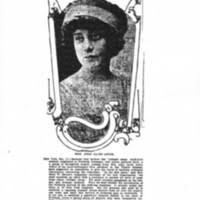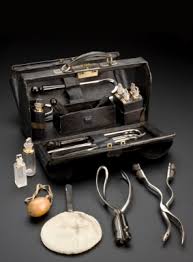Part1-D
- Successfully selling the public, childbearing families, local hospitals & philanthropists on the idea of elective hospitalization and routine using Twilight Sleep drugs, general anesthesia, episiotomy, forceps and manual removal of the placenta on healthy women
- How the profitability of the ‘baby business’ was able to finance a nationwide system of full-service general hospitals and give rise to our current modern, for-profit hospital system.
Dr. Williams’ 1914 book frequently acknowledged the need to convince the public that such a ‘sea change’ or historic departure from the traditional care of midwives and ‘country doctors’ was reasonable and advantageous to them. Dr. Williams wanted people to see hospital-based maternity care for healthy women as leavening the bread dough that would soon give rise to a full-service community hospitals that had a surgery department, clinical labs, x-ray departments and other services that would be useful to every citizen — men of any age, children, the elderly and women who were not of childbearing age.
 As for convincing women themselves, here is his “pitch” in his own words, taken from his 1914 book:
As for convincing women themselves, here is his “pitch” in his own words, taken from his 1914 book:
“To meet their needs [childbearing women], it would be necessary to have a small lying-in hospital located in every town of three or four thousand inhabitants. At first thought, this seems an ideal impossible of realization. But if we consider the matter with attention, without for a moment overlooking the practicalities, we shall see, I think, that such a project by no means presents insuperable difficulties.”
Original Sub-heading: “OBJECTIONS FROM WOMEN”: Of course there will be difficulties in the way of carrying out such a scheme, with its implied sojourn in a hospital for the great majority of women during their accouchement.
The chief objections will come from the women themselves. Indeed, this is about the only opposition that need be considered. Woman is the ruler in America, and what she wishes is never denied her. So it remains only to gain the assent of women to put the project for the wide extension of a lying-in service ….
… the farm wife must be educated before she could be made to see the desirability of this arrangement. The first thought of the average wife is that she cannot possibly be spared from home and that the idea of going to the hospital is not even to be considered.
But as soon as the advantages offered by the hospital – painless childbirth, safety to the offspring, and rapid and permanent recovery – come to be generally known the feasibility of the project will quickly be demonstrated.
What a boon it will be, then, to the six million farm wives of America, when facilities have been provided, and customs have been established, making it certain that she may have the comforts of a lying-in hospital, with adequate medical attendance, to solace her in what would otherwise be the dangerous ordeal of motherhood.”
When Dr. Williams was soliciting active support from husbands and public official or making a pitch for capital endowments from philanthropists — Dr. JWW’s emphasized the benefits of his new system of lying-in hospitals to men and other segments of society.
“the male population of the community will also benefit directly from … lying-in hospitals, because it will be possible to establish in connection with these hospitals, wards or departments of general surgery, for the treatment of various diseases, in many places where it would be impossible to maintain such a hospital service independently, because of insufficient patronage.
The patronage of a lying-in hospital is an assured element, assuming good proportions even in districts relatively sparsely settled.”
As for the cost of all this, JWW remarked:
“There will arise the inevitable question of the monetary cost, and … how such institutions are to be financed. …. once public interest is aroused, the matter of monetary cost will prevent no serious obstacles.”
His historical “plan”, sometimes also referred to by Dr. JWW himself as a ‘scheme’, included three elements:
- That each individual hospital would add a new or expanded maternity ward and hire nurses and other necessary hospital staff.
- The next phase was to promote the patronage of a sufficient number of healthy women as maternity patients and paying customers.
- The last phase began when the hospital was able to use the new revenue generated by their new maternity ward to upgrade, expand and equip itself as a general or ‘community’ hospital capable of providing state-of-the-art comprehensive medical services to local citizens.
Dr. Williams’ plan for the elective hospitalization of healthy maternity patients was not a temporary flash-in-the-pan, it was designed to be a permanent feature of the new business model for general hospitals. This dependable form of patronage (and resulting revenue stream) was correctly identified as necessary to the profitability of hospitals as a stable business with revenue stream large enough to purchase modern technologies and afford capital expansions to increase their market share and make themselves even more profitable.
The Problem no one ever talked about by never putting the words ‘sick people‘ and ‘paying customer‘ into the same sentence!
While the idea of hospitalizing healthy childbearing women seems to come out of left field, Dr. Williams was proposing a solution to a historical problem of great importance that apparently was invisible to all the rest of us (even my hero, Paul Starr, author of The Transformative Social History of Medicine).
Briefly stated, the historic problem of great importance was (and remains!) the simple fact that we don’t have enough sick people as ‘paying customers to support the business model of a first class “modern”, technologically-enhanced hospital; since 1847 (when the AMA came on the scene), America also put taxpayer-generated revenue off-limits as an unacceptable form of “socialized” medicine. And trapped between these two impossibilities is the Reality that modern medical miracles cost a lot of money and somebody, somewhere has to pay up!

A new mom who gave birth at home and the family had enough money to hired a nurse to come in every day to provide postpartum care, fix meals and help with the older children. Families that could afford a nurse were seen by Dr. Williams as being able to pay for hospital-based birth services.
Dr. Williams’ solution to this dilemma was to devise a plan to convince healthy middle & upper-class white women to have their babies in a new system of a lying-in ward in existing hospitals, or new ‘maternity’ hospitals of the tiny 2-10 bed variety owned and run by the town doctor as the first step in creating a revenue stream that would eventually finance a regional general hospital, at least one in every country seat.
When most contemporary Americans hear the word “childbirth”, the very next word in their mind is “dangerous”, followed by “hospital” as a place that changes something horrifically dangerous into something that is very safe.
But Dr. Williams had a very different perspective on normal childbirth, danger, and hospitals. For him, the elective hospitalization of maternity patients was not about the safety of childbearing women or their babies. Considering that in 1914, hospital-acquired (nosocomial) septicemia was the cause of death for more than a third of all maternal deaths (10,000 out of 25,000), so no one, not even Dr. Williams, would or even could credibly claim that hospitalizing healthy laboring women during this pre-antibiotic era was primarily for their safety.
It was like admitting laboring women to a gay bathhouse during the AIDs epidemic before anyone knew how to prevent contagion or successfully treat a rare infection and doing so because it was profitable.
Nope, the hospital problem was lack of money and its solution was more money — lots of it for over a long period of time. Two million American women gave birth every year, which made for a potentially large and steady revenue stream if even half of these women gave birth in a hospital. Electively hospitalizing healthy maternity patients instantly and permanently changed the business model of American hospitals from one that at best was hanging on by its fingernails to gratefully welcomed financial solvency for hospitals that adopted the new market-based model.

Hospital birth in the early 1920s – note that the nurses are standing and moving about, while the new mother, as a “patient”, is appropriately passively as she lies in bed.
Unlike illness, which is seasonal, and injury which is erratic and unpredictable, childbirth, postpartum care for new mothers and nursery care for newborns is a steady, dependable and a stable year-round source of patronage, thus providing the bread and butter income for hospitals.
Hospital administrators, who had been depending solely on sick people for income (established centuries ago to be a failed business model), immediately realized the benefits of expanding their hospital’s acutely-ill patient census to include a large percentage of ‘paying customers’. This market-based model would provide a healthy profit margin simultaneously making up for less profitable hospital services (sick people who couldn’t pay), while eventually allowing them to invest in capital improvements such as new construction and upgraded equipment.
Opening the door to even more innovative and creative ways to monetize hospitals
In addition to new lying-in wards for healthy childbearing women, hospitals began to explore other opportunities to monetize medical and ancillary (non-medical) services. Over subsequent decades, these hospitals started providing outpatient laboratory and x-ray services, diagnostic tests and procedures, cafeterias for the public, gift shops, valet parking, parking garages and as the country’s standard of living rose, so did the idea of elective hospitalization for cosmetic surgery.
Controlling the narrative: QUESTION ~ Are hospitals places where sick people go to die or the place where healthy women go to give birth, a place where babies are born and happy things happened to young healthy families?
An accidental or serendipitous consequence of incorporating normal childbirth into the acute-care setting of hospitals is that it allowed hospital administrators to control the narrative of their business. This PR activity was critical to the overall success (i.e. profitability) of their venture.
 As anyone who has ever visited a medical, surgical or pediatric ward of in a hospital can tell you, there are a lot of disturbing sights and smells. Its beds are filled with the ill and injured who are lost behind a tangle of tubes, and machines that go ‘ping’. Its halls have patients sitting in wheelchairs and others shuffling up and down the halls, while pale and much too quiet small children whose hair has all fallen out and their bodies hooked up to tons of tubes attached to medical equipment are being pulled down the hall in a red wagon by their worried parents.
As anyone who has ever visited a medical, surgical or pediatric ward of in a hospital can tell you, there are a lot of disturbing sights and smells. Its beds are filled with the ill and injured who are lost behind a tangle of tubes, and machines that go ‘ping’. Its halls have patients sitting in wheelchairs and others shuffling up and down the halls, while pale and much too quiet small children whose hair has all fallen out and their bodies hooked up to tons of tubes attached to medical equipment are being pulled down the hall in a red wagon by their worried parents.
Meanwhile, one’s sense of smell is registering the vague smells of alcohol, disinfectants, and the kind of flowery scents that reminds people of a funeral home. It hard not notice that visitors coming out of patient rooms look sad, anxious or preoccupied at best, and sometimes found the corner of a waiting room, sobbing while a family member or nurse tries to comfort them after obviously being told very bad news.
 For centuries, people have quite rationally seen hospitals as a place where people go when something terrible happens to them, or the very old and very sick people go to die. The moniker over the door should be “Nothing nice happens here“. Obviously, this is a ‘hard sell’.
For centuries, people have quite rationally seen hospitals as a place where people go when something terrible happens to them, or the very old and very sick people go to die. The moniker over the door should be “Nothing nice happens here“. Obviously, this is a ‘hard sell’.
But what if YOUR hospital could be associated with the happiest event of all — the birth of a new baby. What if you saw happy families carrying in pink and blue balloons, gifts in colored paper with pretty bows, smiling dads and grandparents as visitors and young women with a pretty new baby in their arms being wheeled down to the door to be discharged?
Consider this scene: A family of three – parents and their son Johnny — are out for a Sunday drive and their route takes them by the local hospital. The boy’s mother point to the hospital and one of the two following dialogues occur:
In a sad voice, mom says “Oh look, honey, that’s where Gramps died”
 Or in an excited and happy voice, mom says: “Oh look, honey, that’s where you were born! I remember the day like it was yesterday, it was such a special and happy time for us.”
Or in an excited and happy voice, mom says: “Oh look, honey, that’s where you were born! I remember the day like it was yesterday, it was such a special and happy time for us.”
It’s not hard to guess which scenario our mythical hospital administrator would prefer, nor to miss just how high the stakes are, what a boon the baby business is to the hospital business turning the “Nothing Nice Happens Here” narrative into “Wonderful Magical Things Happen Here“. The stakes are high for any hospital that wants to stay in business in a country were organized medicine has made publicly funded health care quasi-illegal and instead depends on seducing people into electively hospitalizing is healthiest (but in many ways, it’s most vulnerable) individuals as paying customers.
 Bundled together, the category of elective hospitalization of paying customers for private hospitals was nothing short of a financial miracle. Of course, the beating heart of this new paradigm was the million economically secure (i.e. middle and upper-class) maternity patients that, as paying customers, would give birth in a hospital each year. Accounting for twin and triplets, there would be more than a million newborn babies admitted to the hospital nursery and charged for these services.
Bundled together, the category of elective hospitalization of paying customers for private hospitals was nothing short of a financial miracle. Of course, the beating heart of this new paradigm was the million economically secure (i.e. middle and upper-class) maternity patients that, as paying customers, would give birth in a hospital each year. Accounting for twin and triplets, there would be more than a million newborn babies admitted to the hospital nursery and charged for these services.
And best of all, this accomplished without a single cent of public money or whiff of ‘socialized medicine’, so obviously, the AMA, doctors and hospital administrators were all enormously pleased.
Certainly, this was a Eureka moment for the entire industry. As for Dr. Williams, he realized that a perpetual-motion money machine of his making would eventually make his dreams come true — bright shiny new general hospitals would indeed become “as ubiquitous, if not as abundant, as schoolhouses and libraries”.
By the early 1920s, the new baby business, combined with other types elective hospital care, outpatient services and non-medical profit centers such as dining rooms, parking garages, and gift shops quickly became the economic model for our 20th and 21st-century for-profit hospital system.
This stood in bright contrast to the nationalized system that served our distant relatives on the other side of the “pond” (as Brits like to call the Atlantic Ocean). In the European system, every gainfully employed or independently wealthy adult paid more in taxes every year than a similar American but never had to worry that they, or their children, or an unemployed neighbor would be turned away at the hospital door for lack of funds.
But more to the point being made here, the Brits and other European countries did not turn down public funding from a tax base distributed fairly by income across the country’s entire population and instead chose to funded the country’s hospital system by taking money under false pretenses from childbearing families as an ipso facto tax that fell ONLY on this small (and often financially insecure) segment of their population to provide the bread and butter funding for their hospital system.
Even more bizarre is telling the healthiest and wealthiest of these families that normal childbirth is uniquely dangerous for them, and the reason is because smart, socially successful, educated and economically-secure women like themselves have some kind of genetic damage caused by “the hothouse conditions of civilization” that doesn’t affect immigrants and poor working-class women. That is is to explain why (and they alone!) NEED massive amounts of medical and surgical interventions in what otherwise would have been a natural spontaneous biological process.
Imagine if all the families Dr. JWW was trying to seduce into having hospitals they didn’t want or need had instead agreed to pay a local hospital “tax” (or voluntary contribution) in an amount equal to the hospital bill, but skipped the often degrading hospital experience and also providing a revenue stream to modernize the hospital system in the US. Unfortunately, that isn’t what happened.
Dr. Williams turned the story as we think of it today on its head in a remarkable bit of reverse engineering. To our modern perspective, this seems like a “the tail wagging the dog” scenario, but in his version, the ‘tail’ is the full-service community hospitals being pulled along by the money generated by maternity department who provide childbirth services to a majority healthy population of women with normal term pregnancies.
The profitability of the ‘baby business’ is what made everything else – the modern hospital system — possible.
Continue to Part 2-A: Dr. JWW’s Little Book and The Pentagon Paper – the two stories have in common when it comes to mis- and disinformation, systemized harm, and inability to of those in charge to admit that they were wrong
Word Count 2650


